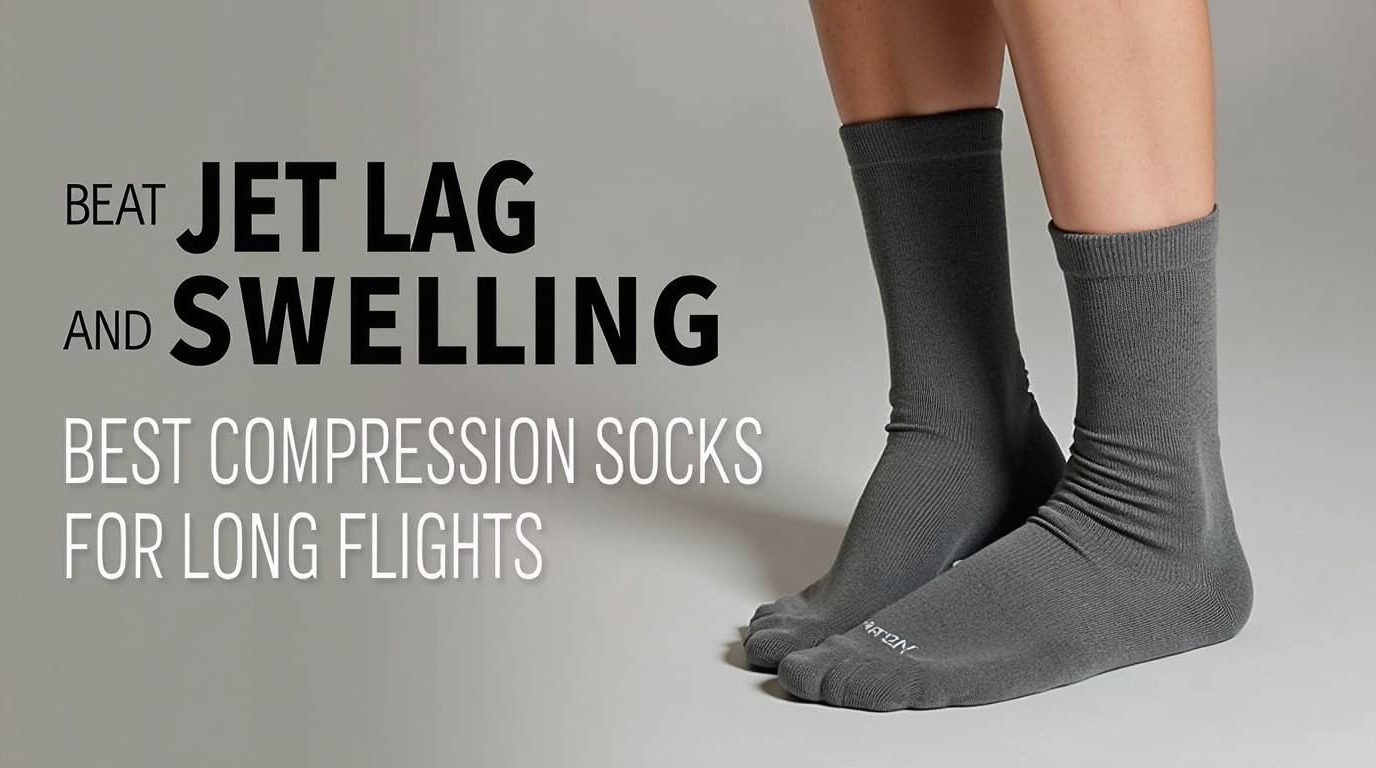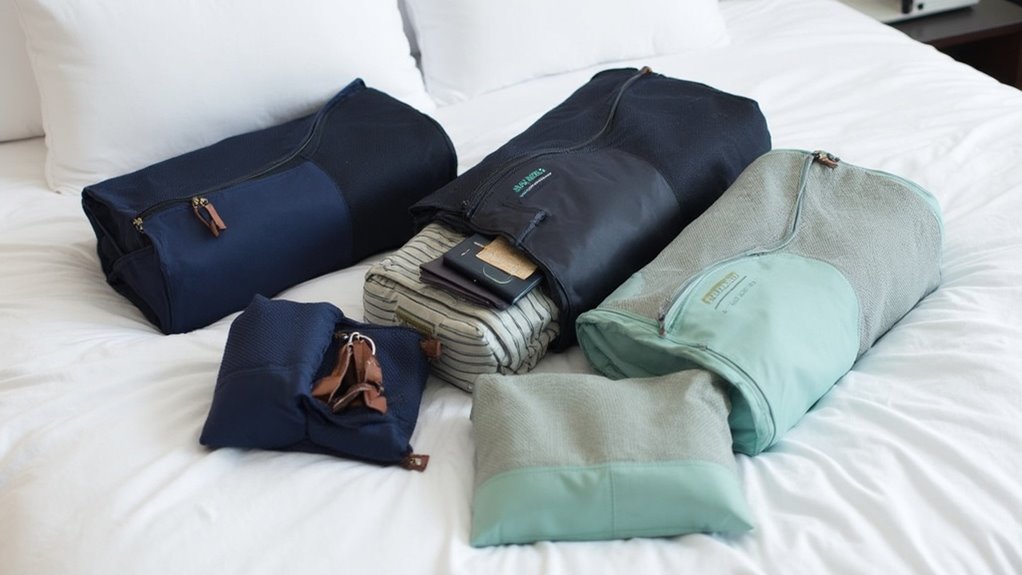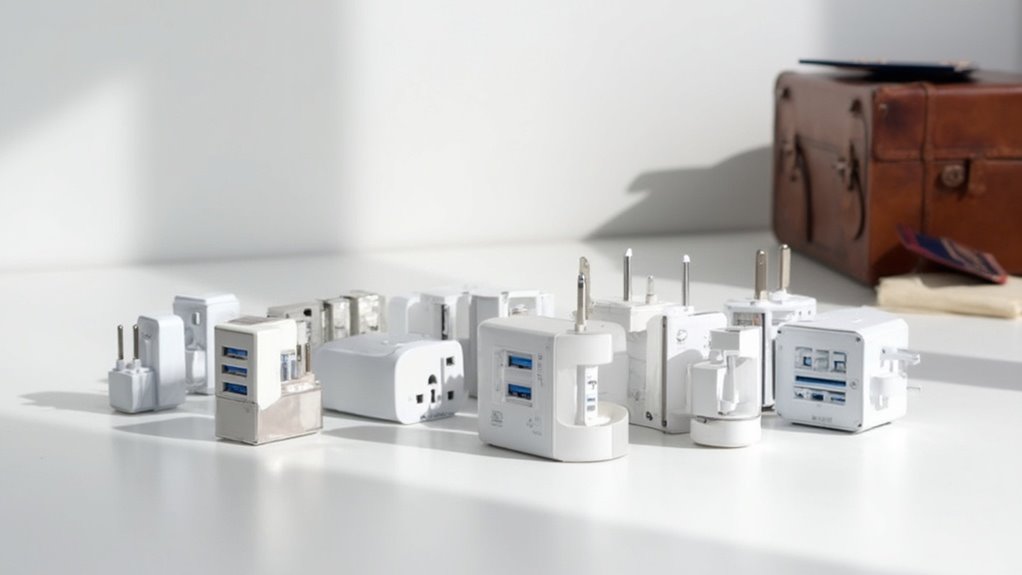Table of Contents Show
There may be products. Products are independently selected by our editors. We may earn an affiliate commission from the links with no charge to you, example: as Amazon Affiliate.
We recommend compression socks rated 15-20 mmHg for most travelers to combat jet lag and swelling on long flights. These knee-high socks provide graduated pressure that’s tightest at the ankle, promoting better blood flow at 35,000 feet. Top picks include Bombas Everyday and Comrad’s travel socks, which deliver essential support while remaining comfortable. For flights over four hours or travelers with health concerns, consider medical-grade options at 20-30 mmHg. Let’s explore how to choose the perfect pair for your journey.
Key Takeaways
- Compression socks with 15-20 mmHg graduated pressure effectively reduce swelling and combat jet lag during medium to long flights.
- Top-rated Bombas Everyday and Comrad travel compression socks provide optimal 15-25 mmHg support for extended air travel.
- Medical-grade compression socks (20-30 mmHg) are essential for flights over four hours to prevent deep vein thrombosis.
- Choose knee-high socks with moisture-wicking materials and graduated pressure that’s tightest at ankles, loosening toward knees.
- Put on compression socks before boarding, and ensure proper fit by measuring calves and consulting manufacturer sizing charts.
Why Compression Socks Matter for Air Travel
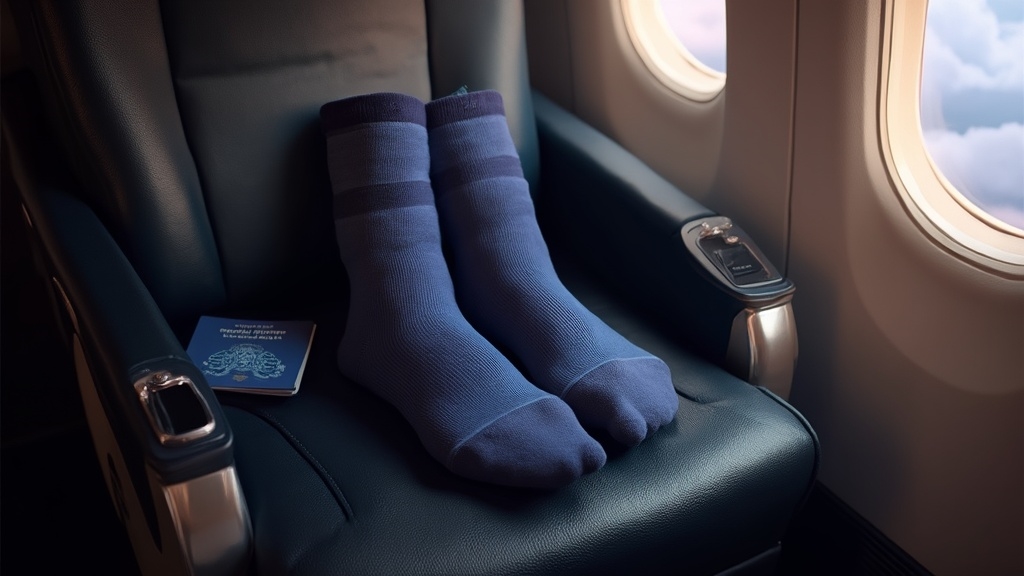
While many travelers overlook the importance of proper legwear during flights, compression socks play an essential role in maintaining comfort and health at 35,000 feet. We’ve found that knee-high compression socks provide significant support during long flights by promoting better blood flow and helping reduce swelling in feet and ankles.
The benefits of compression socks extend beyond basic comfort. With approximately 1 in 20 people developing deep vein thrombosis in their lifetime, these specialized socks act as a protective measure during air travel. They work through graduated pressure, being tightest at the ankle and gentler toward the knee, which helps combat the effects of prolonged sitting and cabin pressure. When choosing compression socks for travel, we recommend looking for pairs rated at 15-20 mmHg for ideal support without discomfort. Additionally, proper sizing ensures optimal compression and fit, enhancing circulation and reducing fatigue during your journey. Compression socks are often constructed from moisture-wicking materials that keep your feet dry, adding another layer of comfort for extended wear.
Understanding Compression Levels and Their Benefits
Since compression levels can seem confusing at first glance, let’s break down what the numbers actually mean for your travel comfort. Measured in mmHg, different levels serve specific purposes during air travel. For shorter flights, 8-15 mmHg offers basic comfort, while 15-20 mmHg helps alleviate jet lag and minor swelling. For long flights, we recommend medium compression (20-30 mmHg) to reduce swelling and optimize blood flow.
- Graduated compression design guarantees pressure decreases from ankle to knee, promoting healthy venous return, which is essential for supporting self-reliance during travels.
- 8-15 mmHg: Perfect for first-time compression sock users and short flights.
- 15-20 mmHg: Ideal for medium-length flights and managing minor swelling.
- 20-30 mmHg: Medical-grade support for long-haul flights and DVT prevention.
- Consistent wear during flights considerably reduces leg fatigue and discomfort. Historical figures such as Mary Queen of Scots clearly illustrate the importance of maintaining health during extended journeys.
Top-Rated Compression Socks for Long Flights
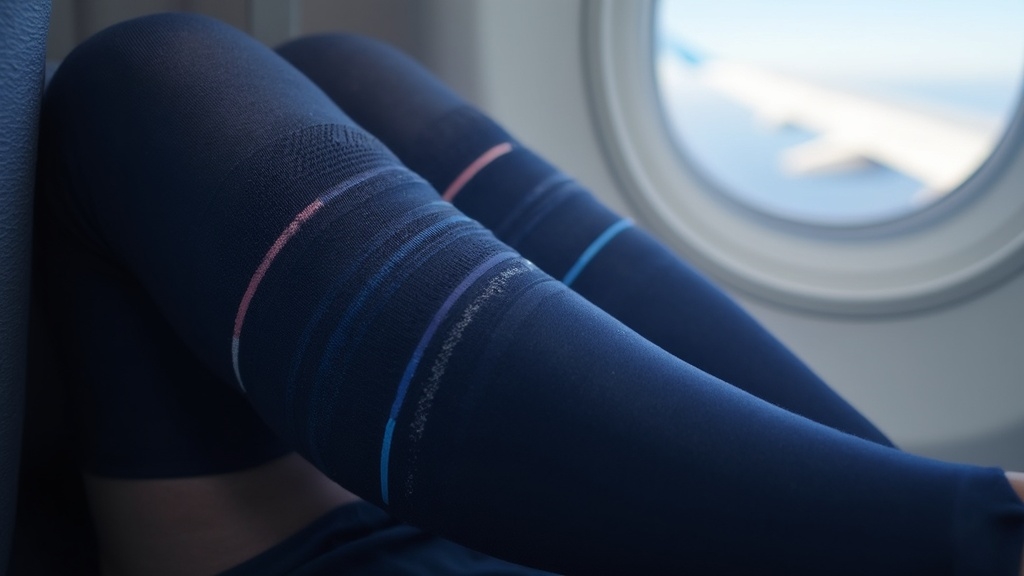
After extensive research and testing, we’ve identified several top-performing compression socks that excel during long-haul flights. The Bombas Everyday compression socks offer excellent graduated pressure at 15-20 mmHg, providing significant benefits for your feet and legs during extended travel. Engaging in exploration can foster deeper connections and enhance the overall travel experience. For those seeking stronger support, Comrad’s travel compression socks deliver 15-25 mmHg of pressure.
Budget-conscious travelers will appreciate FuelMeFoot compression socks, which provide robust 20-30 mmHg compression at just $15. The Sockwell Circulator, while pricier at $30, offers gender-specific sizing and firm graduated pressure that’s ideal for preventing Deep Vein Thrombosis and reducing swelling in the legs. Each option effectively manages circulation through graduated pressure, making them essential companions for long flights exceeding four hours. Additionally, just like a first aid kit is crucial for emergencies, having the right compression socks can significantly enhance your travel comfort.
Features to Look for When Choosing Travel Socks
When shopping for compression socks for air travel, several key features can make or break your comfort during long flights. We recommend choosing socks with a graduated pressure design of 15-30 mmHg to effectively reduce swelling and promote circulation. Breathable materials with moisture-wicking properties guarantee your feet stay dry and comfortable throughout your journey. Exploring new territories can also help cultivate the self-confidence you need for your travels.
- Look for knee-high options that provide extensive coverage and work well with various types of footwear.
- Choose socks made from breathable materials like nylon or merino wool for peak moisture management.
- Verify proper graduated pressure design for maximum circulatory benefits.
- Select socks with extra support features like arch support and cushioned soles.
- Consider ease of application, especially with higher compression levels. Additionally, ceramic technology found in hair tools may also help minimize discomfort during travel by promoting even heat distribution.
How to Properly Wear and Care for Your Compression Socks
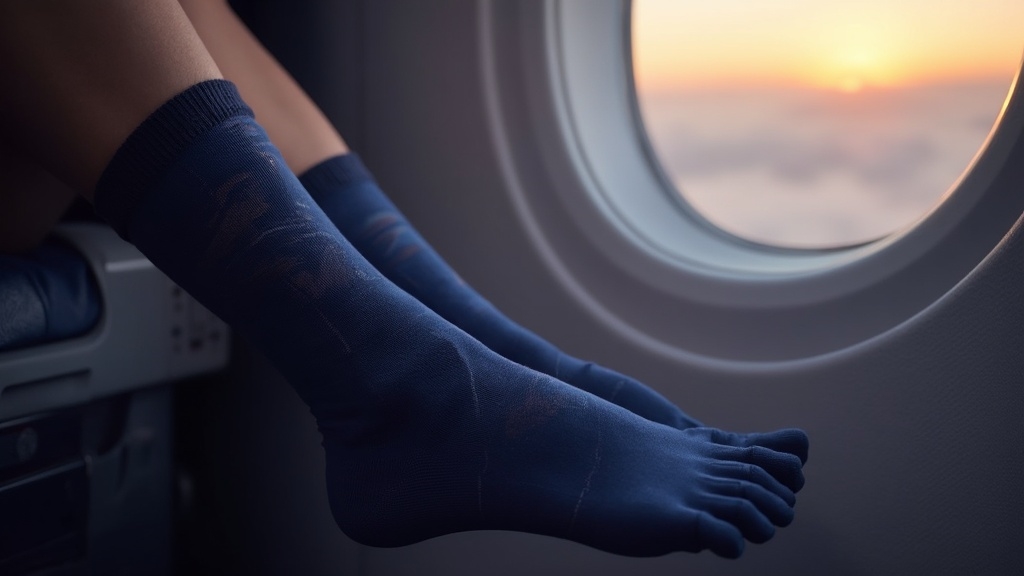
Proper care and wear techniques can greatly extend the life of your compression socks while maximizing their benefits. To properly wear compression socks, we recommend putting them on first thing in the morning before swelling occurs. Start by measuring your legs to guarantee a suitable fit, then roll down the top cuff and slide them on smoothly to reduce swelling and avoid wrinkles. Prioritizing self-care routines can further enhance your overall comfort during long periods of sitting.
While compression socks provide excellent protection against swollen ankles during long flights, they should be removed before bedtime unless your doctor advises otherwise. Follow care instructions carefully by hand-washing in cold water or using a gentle cycle, and avoid fabric softeners. We suggest you monitor signs of wear regularly, as compression socks typically need replacement every 6-12 months with frequent use. Additionally, consider enjoying activities like snorkeling in Fiji to promote circulation and further reduce swell during your travels.
Medical Benefits and Safety Considerations
Understanding the medical benefits of compression socks reveals why they’re essential for air travel safety. When we’re on long flights, these special socks help prevent Deep Vein Thrombosis by promoting healthy blood flow through graduated compression. The recommended 15-20 mmHg pressure level offers both comfort and protection during your journey.
- Graduated compression design works naturally with your body, tightest at ankles and gradually loosening up
- Effectively reduces leg swelling during flights over four hours
- Supports circulation to help prevent potentially dangerous blood clots
- Safe for all-day wear, including sleep when medically advised
- Requires medical consultation for those with specific conditions like diabetic foot issues
Expert Recommendations for Different Travel Scenarios
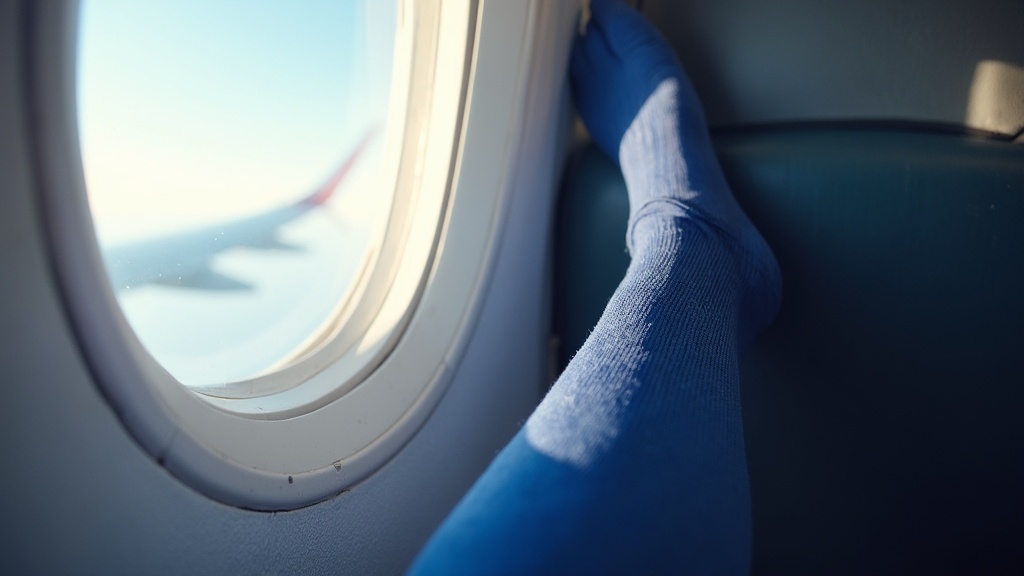
Different travel scenarios call for specific compression sock strategies, building on the medical benefits we’ve explored. For everyday travelers, we recommend compression socks with a 15-20 mmHg compression level that are comfortable enough to wear all day long. They’ll keep your legs and feet feeling fresh while maintaining healthy blood circulation.
When you’re flying for more than four hours, we suggest upgrading to medical-grade compression socks (20-30 mmHg) to prevent deep vein thrombosis. This is especially important for pregnant travelers, who face higher DVT risks. Many travelers report significant health benefits, including reduced swelling and fatigue upon arrival. Don’t worry about sacrificing style – modern compression socks come in fashionable designs that’ll complement any travel outfit while delivering the protection you need.
Sizing Guide and Comfort Tips for Extended Wear
The perfect fit makes all the difference when choosing compression socks for long flights. We recommend measuring your calf and consulting the manufacturer’s sizing chart to guarantee ideal comfort during extended wear. For most travelers, compression levels of 15-20 mmHg provide ideal support without being too restrictive. Look for moisture-wicking nylon or breathable merino wool materials to keep your feet dry and comfortable throughout your journey.
- Measure your calves at their widest point for accurate sizing
- Start with shorter wear periods to adjust to graduated pressure
- Check that socks fit snugly but don’t leave marks or cause pain
- Choose moisture-wicking materials for maximum comfort
- Confirm you can move your toes freely while maintaining compression
Frequently Asked Questions
What Kind of Compression Socks Are Best for Long Flights?
We recommend 20-30 mmHg knee-high compression socks made from moisture-wicking nylon or merino wool. They’ll keep your legs comfortable during flights while offering graduated support that’s snug at ankles, looser at knees.
Do Compression Socks Help With Swelling on Long Flights?
We recommend compression socks for their proven benefits in preventing swelling during flights. They’ll improve your blood circulation, reduce leg fatigue, and enhance travel comfort while supporting your overall flight wellness.
Should You Wear Compression Socks for Long Haul Flights?
We strongly recommend wearing compression socks for long flights to prevent DVT, reduce leg fatigue, and improve circulation. They’re especially beneficial for flights over four hours and pregnant travelers.
Do Compression Socks Help With Jet Lag?
We’ve seen compression socks ease travel fatigue and jet lag recovery by boosting blood circulation during flights. When paired with movement breaks and proper hydration, they’re a valuable wellness accessory for smoother journeys.
Conclusion
We’ve found that wearing compression socks during long flights isn’t just about comfort – it’s a proven way to protect our circulatory health. From reducing swelling to preventing deep vein thrombosis, the right pair makes all the difference. Whether you’re a frequent flyer or occasional traveler, investing in quality compression socks can transform your flying experience. Let’s make every journey healthier, one flight at a time.
